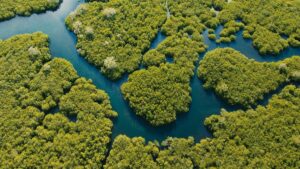 A global study based on more than 216,000 simulations has found that mangrove forests wider than 500 metres offer far more effective coastal protection than previously assumed. The research, led by the Deltares institute, shows that these broad mangrove belts reduce incoming wave heights by at least 70% regardless of wave intensity, water levels, or local conditions.
A global study based on more than 216,000 simulations has found that mangrove forests wider than 500 metres offer far more effective coastal protection than previously assumed. The research, led by the Deltares institute, shows that these broad mangrove belts reduce incoming wave heights by at least 70% regardless of wave intensity, water levels, or local conditions.
Using the SWAN (Simulating WAves Nearshore) model, researchers analyzed 15,773 coastal locations worldwide with mangrove cover. From this dataset, 1,000 representative situations were selected to simulate wave reduction performance under a variety of environmental conditions. The results produced tens of millions of data points and highlighted a clear trend: wider mangroves are consistently more effective at weakening wave energy before it reaches inland areas.
The presence of mudflats in front of mangrove forests further enhances this wave-reduction effect, especially in regions with high wave activity. These muddy zones act as a preliminary buffer, absorbing much of the wave force before it even reaches the mangrove line.
Currently, coastal regulations in many countries recommend or mandate mangrove green belts between 50 and 200 metres wide. However, the new findings reveal that in belts narrower than 500 metres, wave reduction is unreliable and highly dependent on local variables such as wave height and vegetation density. Only wider belts—covering more than 500 metres—consistently reduce wave energy by three-quarters or more.
This research suggests a strong case for updating coastal protection policies to require significantly broader mangrove zones. Wider mangrove forests not only improve defense against erosion, storm surges, and flooding but also support biodiversity, carbon sequestration, and overall ecosystem resilience.
The study emphasizes the importance of both preserving existing mangrove ecosystems and expanding restoration efforts. In light of increasing climate risks, incorporating wider mangrove belts into coastal planning could play a vital role in safeguarding vulnerable communities and natural habitats across the globe.
